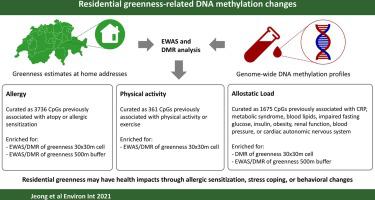Environment International ( IF 11.8 ) Pub Date : 2021-10-21 , DOI: 10.1016/j.envint.2021.106945 Ayoung Jeong 1 , Ikenna C Eze 1 , Danielle Vienneau 1 , Kees de Hoogh 1 , Dirk Keidel 1 , Thomas Rothe 2 , Luc Burdet 3 , John W Holloway 4 , Debbie Jarvis 5 , Florian Kronenberg 6 , Gianfranco Lovison 7 , Medea Imboden 1 , Nicole Probst-Hensch 1

|
Background
Residential greenness has been associated with health benefits, but its biological mechanism is largely unknown. Investigation of greenness-related DNA methylation profiles can contribute to mechanistic understanding of the health benefits of residential greenness.
Objective
To identify DNA methylation profiles associated with greenness in the immediate surroundings of the residence.
Methods
We analyzed genome-wide DNA methylation in 1938 blood samples (982 participants) from the Swiss Cohort Study on Air Pollution and Lung and Heart Diseases in Adults (SAPALDIA). We estimated residential greenness based on normalized difference vegetation index at 30 × 30 m cell (green30) and 500 m buffer (green500) around the residential address. We conducted epigenome-wide association study (EWAS) to identify differentially methylated CpGs and regions, and enrichment tests by comparing to the CpGs that previous EWAS identified as associated with allergy, physical activity, and allostatic load-relevant biomarkers.
Results
We identified no genome-wide significant CpGs, but 163 and 56 differentially methylated regions for green30 and green500, respectively. Green30-related DNA methylation profiles showed enrichments in allergy, physical activity, and allostatic load, while green500-related methylation was enriched in allergy and allostatic load.
Conclusions
Residential greenness may have health impacts through allergic sensitization, stress coping, or behavioral changes. Exposure to more proximal greenness may be more health-relevant.
中文翻译:

与住宅绿色相关的 DNA 甲基化变化
背景
住宅绿色与健康益处相关,但其生物学机制在很大程度上是未知的。研究绿色相关的 DNA 甲基化谱有助于从机制上理解住宅绿色对健康的益处。
客观的
确定与住宅周围环境中的绿色相关的 DNA 甲基化谱。
方法
我们分析了 1938 份血液样本(982 名参与者)中的全基因组 DNA 甲基化,这些样本来自瑞士成人空气污染与肺病和心脏病队列研究 (SAPALDIA)。我们根据住宅地址周围 30 × 30 m 单元格 (green30) 和 500 m 缓冲区 (green500) 的归一化差异植被指数估算住宅绿化度。我们进行了表观基因组范围的关联研究 (EWAS) 以识别差异甲基化的 CpG 和区域,并通过与之前 EWAS 识别为与过敏、身体活动和同源负荷相关生物标志物相关的 CpG 进行比较来进行富集测试。
结果
我们没有发现全基因组显着的 CpG,但是 green30 和 green500 分别有 163 和 56 个差异甲基化区域。Green30 相关的 DNA 甲基化谱显示过敏、身体活动和非稳态负荷富集,而 green500 相关的甲基化在过敏和非稳态负荷方面富集。
结论
住宅绿色可能通过过敏、压力应对或行为改变对健康产生影响。接触更接近的绿色可能与健康更相关。


























 京公网安备 11010802027423号
京公网安备 11010802027423号